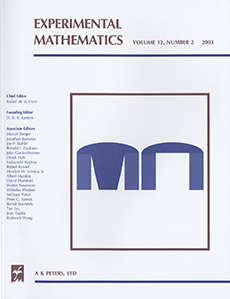Abstract
The EKG or electrocardiogram sequence is defined by {\small $a(1) = 1$, $a(2) =2$} and, for {\small $n \ge 3$, $a(n)$} is the smallest natural number not already in the sequence with the property that {\small ${\rm gcd} \{a(n-1), a(n)\} > 1$}. In spite of its erratic local behavior, which when plotted resembles an electrocardiogram, its global behavior appears quite regular. We conjecture that almost all {\small $a(n)$} satisfy the asymptotic formula {\small $a(n) = n (1+ 1/(3 \log n)) + o(n/ \log n)$} as {\small $n \to \infty$}; and that the exceptional values {\small $a(n)=p$} and {\small $a(n)= 3p$}, for {\small $p$} a prime, produce the spikes in the EKG sequence. We prove that {\small $\{a(n): n \ge 1 \}$} is a permutation of the natural numbers and that {\small $c_1 n \le a (n) \le c_2 n$} for constants {\small $c_1, c_2$}. There remains a large gap between what is conjectured and what is proved.
Citation
J. C. Lagarias. E. M. Rains. N. J. A. Sloane. "The EKG Sequence." Experiment. Math. 11 (3) 437 - 446, 2002.
Information




